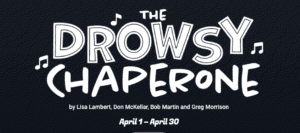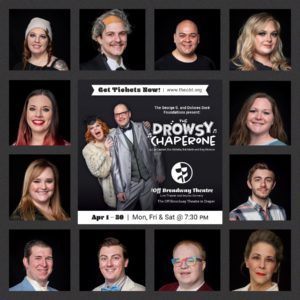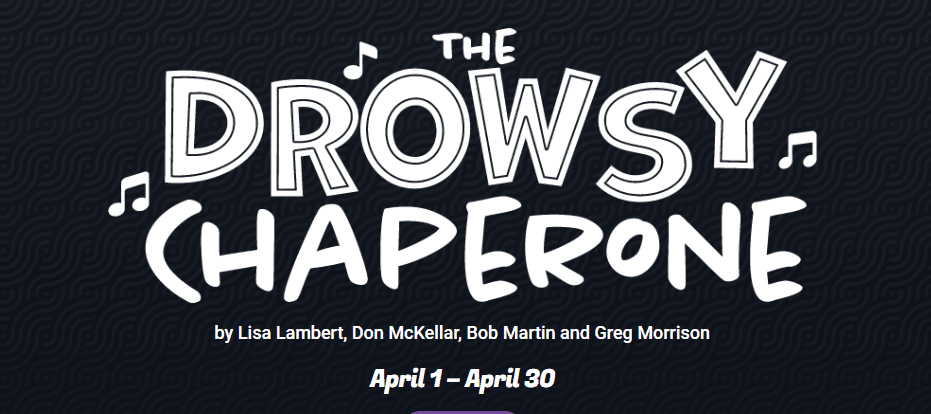DRAPER — A cursory glance at the production history of The Off-Broadway Theatre reveals what an intrepid choice it is for the company to produce The Drowsy Chaperone. While many of their plays are original adaptations and spoofs written by the company’s founder Eric R. Jensen, Chaperone is a clear step towards mainstream titles with greater marketing appeal. With the company’s improvisational theater roots and rich comedic history, this hilarious musical seems a natural choice to expand their brand. Unfortunately, it often felt as if the massive undertaking was more production than the company was able to handle.

The Drowsy Chaperone (with a book by Bob Martin and Don McKellar and music and lyrics by Lisa Lambert and Greg Morrison) is a brilliant play within a play that is presented as a shared evening with the narrator-protagonist, Man in Chair. The musical is a soliloquy of Man in Chair’s cheerful cynicism about life and theatre as he listens to and expounds upon a recording of the fictional prohibition-era play also titled The Drowsy Chaperone. The show requires intense dancing and singing, as well as linguistic humor and high-end physical farce that utilizes many complicated set pieces, culminating in a giant airplane that fills the stage at the end. It is a demanding production for a large venue with a massive budget. For the Off-Broadway production directed by Jake Andersen in the old Draper Historic Theatre, it just felt like trying to bite off too much. Anderon’s curious decision to double cast the show compounded the production’s difficulties.
One way this was noticed was how the set felt oddly organized. Much of the show centers on the narration of Man in Chair, and the Drowsy Chaperone characters entering his apartment, but he is set far on the stage left side which reads backwards to an audience. Most of the setting was simple flats but there was also vivid projection on the backdrop that was a jarring contrast to the basic set. And some of the projections included images with visible stock photo watermarks. After intermission, nearly the entire apartment setting simply disappeared. While the play calls for many exit and entrance points that were used well, the space felt crowded.
The production begins with Ryan Bullock’s droll Man in Chair stating that he hates theatre. The monologue’s delivery was fun, as it was full of pithy quips and well crafted anecdotes, which Bullock delivers with ironclad deadpan. Bullock’s portrayal had a pleasantly flamboyant flair that allowed for lines alluding to Man in Chair’s ambiguous sexual undertones to land well with the audience. He did not engage in any superfluous stage business, but at times seemed to not be reacting to what he and the audience were engaging with either.

Man in Chair introduces the audience to the inner play’s central conflict: starlet Janet Vandergraff (played by Eleisha Keen) is to be married to a nobody named Robert (played by Tyler Newton), which will end her performing career. Janet and Robert are not to see each other as it is the day of their wedding, and so Janet’s imbibing chaperone (played by Jessica Andrews) half-heartedly attempts to keep them separate as the chaperone drinks herself drowsy. Andrews portrayal of the Drowsy Chaperone was delightful. She was comically detached, and singularly focused on finding her next adult beverage.
The B-Plot of this inner show focuses on Janet’s producer, Feldzieg (played by Kasey Capanna), who is desperate to break up the wedding. He is followed everywhere by Kitty (played by Cassidy Lewis), who wants to prove she can be the next star when Janet retires, as well as a pair of mafia thugs in disguise as bakers who are going to do him in if Janet does retire. Their hijinks were well played, and the actors clearly found the jokes in the script. The director’s background with improvisation helped the actors to know how to deliver their jokes, but often this came at the expense of authentic character moments of listening and engaging with their ensemble. The show felt like a collection of comedy sketches that were narrated by intermittent the Man in Chair’s stand-up routines. The comedy lacked the humor and liveliness that would make the characters feel connected to one another.
Nowhere was this more pronounced than in the quirky characters of Adolpho (played by Teki Wolfgramm), Mrs. Tottendale (played by Emily Simmons), and Underling (played by Dan Martinez). Aldolpho’s main storyline is that Feldzieg manipulates him to try and seduce Janet. Instead, he finds himself seducing the chaperone with his Latin charms. Wolfgramm brought a buoyancy and pizzaz to the character and was eye-grabbing every time he entered the space. He was strongly committed to his character’s lasciviousness as heard in his over-the-top accent and many vigorous pelvic thrusts. Tottendale and Underling, however, mostly serve as a vehicle for spit-takes and exposition. In one scene, Tottendale is teaching Underling how to discreetly serve alcohol at the wedding but she forgets she has done so which leads to a series of hysterical spit-takes – or would have if Simmons had actually spit rather than simply tossing the cups of water onto Underling. The choice seemed to undercut the entire scene and was another missed opportunity in directing the characters to play up their relationships and comedy.
While Janet and Robert’s wedding nearly falls apart through a miscommunication, the play-within-the-play ends with a total of four weddings. At one point, Man in Chair says, “That’s what musicals are all about, right? Romantic fantasy. Falling in love at the drop of the hat!” However, the lack of chemistry between any of the characters was disenchanting. While I value family-friendly theatre and can understand the choice to generally not over-emphasize the romance or sexual overtones, it was disappointing that the characters on stage had no romantic chemistry with one another at all. Even Aldolpho and the Chaperone had a very tame interlude that bordered on awkward.
Overall, the show had great comedic moments, but it never entirely came together. The sound mixing was often too quiet for the ensemble numbers or too loud for soloists. The other characters had lovely moments of dancing or singing, but usually not both. Again, I cannot emphasize enough that The Drowsy Chaperone is a challenging play. As the Man in Chair tells his audience, “I know it’s not a perfect show… but it does what it’s supposed to do: it takes you to another world. And it gives you a little tune to carry within your head.” Off Broadway’s production of The Drowsy Chaperone was light hearted, playful, and left me with some catchy tunes. However, the production fell short of expectations and ultimately felt quite far off-broadway.
[box]The Off-Broadway Theatre production of The Drowsy Chaperone plays Fridays, Saturdays, and Mondays at 7:30 PM and Saturdays at 2 PM through April 30 at Draper Historic Theatre (12366 South 900 East, Draper). Tickets are $12-16. For more information, visit theobt.org.[/box]

